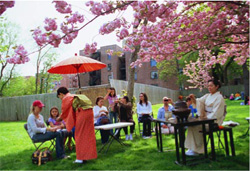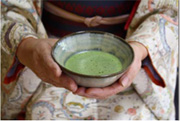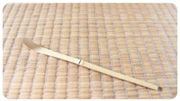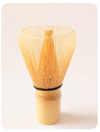Home > Highlighting JAPAN > Highlighting Japan JUNE 2012 > Sado
Highlighting JAPAN
[SERIES] STUDENTS'CORNER: Ways of Japan
Sado
In the first installment of our new series introducing Japanese culture and society to younger readers, we take a look at the tea ceremony and challenge you to answer our quiz.

An outdoor tea ceremony held at the Cherry Blossom Festival in White Plains in the state of New York, United States, May 2011. It is not unusual in Japan for tea ceremonies to be held outside.
Credit: AFLO

Matcha, or powdered green tea, freshly mixed with hot water
The history of the tea ceremony extends back about 500 years. In the tea ceremony, tea is made by dissolving powdered tealeaves, called matcha, in hot water. There are prescribed body movements for making the tea, handling the utensils and for drinking the tea itself, and many years of training are needed to perfect these movements. However, the most important aspect of the art of the tea ceremony is to think of the occasion as a once-in-a-lifetime opportunity to meet other people and experience the host's sincerity towards the guests. The host cares not only for the tea, but also for the garden, utensils, decorative flowers, and the sweets to be served with the tea. And the guest expresses gratitude for this hospitality through prescribed body movements and words. Although some people may feel that the tea ceremony is extremely rigid and formal, enjoying tea on tatami mats, the traditional Japanese flooring material, is in fact naturally relaxing.
The tea ceremony is taught in special sado schools all over Japan, as well as in Beijing, London, Paris, New York, and other major cities around the world. How about visiting a school near you?

Q1: This bamboo stick utensil is called a "chashaku." How do you think it is used?
A. For discreetly scratching an itch
B. For stirring matcha powder in hot water
C. For scooping matcha powder from a tea container

Q2: This utensil is called a "chasen." How do you think it is used?
A. For cleaning teacups after use
B. For stirring matcha powder in hot water
C. For sweeping away dust at the entrance to the tea ceremony room
© 2009 Cabinet Office, Government of Japan






